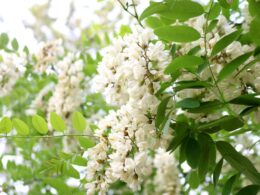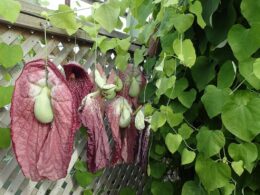Meet Stachys Byzantina and Its Cultivars
The lambs ear flower (Stachys Byzantina) is a small, delicate, woolly plant that is native to the Middle East. It gets its name from its soft, furry leaves, which resemble the ears of a lamb. Although it is not technically a flower, the plant produces small, insignificant blooms that are typically removed before they have a chance to open.
The Lambs Ear flower blooms in early summer, producing small, pink flowers that are clustered together on long stems. The plants typically grow to a height of 12-18 inches and spread 12-24 inches. The lambs ear flower is rabbit and deer resistant. There are many cultivars of lambs ear flowers, all of which vary in size, color, and leaf shape. The most popular cultivars are:
Big Ears or Helen von Stein
The big ears plant, also known as Helen von Stein, is one of the most popular cultivar of the lambs war flower. Its large, fuzzy leaves are bigger and greener than of its mother plant. It doesn’t bloom often, but when it does, there appear sporadic spikes that grow above the foliage. The flowering stems are densely covered with small purple flowers and are very often cut down so that the ground cover could be impressive on its own.
Silver Carpet
Silver carpet is another common cultivar of the lambs ear plant. The leaves of the silver carpet are covered in a dense layer of silvery-white hairs, which give the plant its striking appearance and also help to reflect heat and light. It is a popular choice for gardens and decorative landscaping due to its low maintenance requirements.
Cotton Boll
This cultivar’s name comes from the fact that its flowers resemble cotton balls. This one might have the most silvery foliage out of all the varieties of lambs ear flower. The leaves grow in rosettes and are ca 5 inches tall. The flower spikes, though, can get even twice or thrice as big! Just like other lambs ears, this one is evergreen, and dies only in harsh winters. It does well in humid areas, provided it has well-drained soil.
Lambs Ear Care
Lambs ear is a hardy perennial that is known for its soft, velvety leaves. Plenty of gardeners choose to decorate their gardens with this perennial plant because it’s easy to grow and requires little maintenance. Lambs ear can be started from seed, but it’s easier to propagate from division or cuttings.
Growing
If you’re starting from seed, sow the seeds in late winter or early spring. Once the seedlings have sprouted, space the plants so that they are about 12 inches apart. If you’re propagating from division or cuttings, wait until early spring or fall to divide the plants or take cuttings. When dividing plants, dig up the entire plant and carefully separate it into smaller sections. To take cuttings, snip off a 2-3 inch piece of stem from a healthy plant. Keep the cutting moist until it has rooted, then plant it in a pot or in the ground.
Planting
When planting, choose a sunny spot with well-drained soil. The plant is drought tolerant, however it will do it good to get some partial shade. While it can easily withstand hot temperatures, Stachys byzantina does not tolerate cold. It could be chosen as a ground cover even withing the walking area. Stachys byzantina is not a fast grower. It grows similarly to lavender, and so unlike their herbaceous relatives, they don’t overwhelm other plants. It is safe to plant it
Fertilizing
Lambs ear is a low-maintenance plant that doesn’t need much fertilizer. However, you can give it an occasional boost with compost or organic matter. The best time to fertilize lambs ear is in early spring, just as the plant is beginning to emerge from dormancy. A balanced fertilizer can be applied directly to the soil around the base of the plant. However, it is important not to overfertilize, as this can damage the roots and lead to poor growth. Alternatively, a slow-release fertilizer can be used, which will provide a steady supply of nutrients over a longer period of time.
Tending
To keep this woolly foliage healthy and impressive, gardeners are advised to regularly tend to it. The plant needs some deadheading, especially during bloom time. Flower stalks are very often cut down to let the fuzzy foliage shine on its own. All the dried or spoiled leaved should be removed as soon as possible. Last but not least, Stachys byzantina may benefit from replanting if the soil has been contaminated with fungi, or it if it has too little space to grow.
Common Problems With Lambs Ear Flowers
The most common problem with lambs ear flower is rotting. Gardeners often don’t realize the importance of this plant’s origins. Lambs ear requires a mostly dry environment, and high humidity will result in the plant rotting quicker than it bloomed. Outside the Middle East, dry and warm lands that provide some afternoon shade are best to grow this plant. In addition to that, they are susceptible to fungi that may develop in the soil, especially if that has been overwatered.
Toxicity of Stachys Byzantina
Lambs ear is considered to be non-toxic to humans, and it has a long history of use in traditional medicine. The plant’s leaves are often used as a topical compress for bruises and swellings, and they can also be eaten raw or cooked. Some people use it to soothe a bee sting. However, some people may experience an allergic reaction to lambs ear, so it is always best to test a small area of skin before using the plant medicinally. Moreover, the plant is also perfectly safe for pets and any outdoor animals.



















